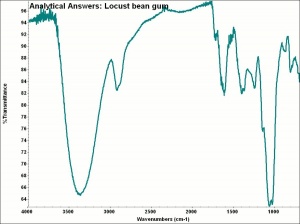Difference between revisions of "Locust bean gum"
| Line 2: | Line 2: | ||
A polysaccharide produced from the seeds of the [[carob]] tree, ''Ceratonia siliqua'', native to the Mediterranean region. Locust bean gum, or carob gum, is composed of proteins (albumins, globulins, prolamins, gluteline), carbohydrates (sucrose, dextrin pentosan, mannose, galactose), ash, fat, fiber, and moisture. Locust bean gum is produced from grinding the bean kernels of the carob tree to a fine powder. It dissolves in hot water (82 C) and cools to form a stable gel that is unaffected by pH changes or additions of salts. Solutions of locust bean gum may be gelled with an addition of 4% borate then reversed by the addition of mannitol or an acid. Locust bean gums have been detected in the wrappings of Egyptian mummies. They are excellent film formers and are currently used as dye thickeners and sizes for food, cosmetics, textiles, and paper. | A polysaccharide produced from the seeds of the [[carob]] tree, ''Ceratonia siliqua'', native to the Mediterranean region. Locust bean gum, or carob gum, is composed of proteins (albumins, globulins, prolamins, gluteline), carbohydrates (sucrose, dextrin pentosan, mannose, galactose), ash, fat, fiber, and moisture. Locust bean gum is produced from grinding the bean kernels of the carob tree to a fine powder. It dissolves in hot water (82 C) and cools to form a stable gel that is unaffected by pH changes or additions of salts. Solutions of locust bean gum may be gelled with an addition of 4% borate then reversed by the addition of mannitol or an acid. Locust bean gums have been detected in the wrappings of Egyptian mummies. They are excellent film formers and are currently used as dye thickeners and sizes for food, cosmetics, textiles, and paper. | ||
| − | + | [[[SliderGallery rightalign|aaiLOCUSTGUM.jpg~FTIR]]] | |
== Synonyms and Related Terms == | == Synonyms and Related Terms == | ||
locust kernel gum; carob bean gum; carob-seed gum; carob gum; St. John's bread; algarroba; Johannisbrotmehl; Arobon; ''Ceratonia siliqua'' | locust kernel gum; carob bean gum; carob-seed gum; carob gum; St. John's bread; algarroba; Johannisbrotmehl; Arobon; ''Ceratonia siliqua'' | ||
| − | + | == Physical and Chemical Properties == | |
| − | |||
| − | == | ||
Soluble in hot water, cools to form gel. | Soluble in hot water, cools to form gel. | ||
Latest revision as of 09:22, 16 October 2022
Description
A polysaccharide produced from the seeds of the Carob tree, Ceratonia siliqua, native to the Mediterranean region. Locust bean gum, or carob gum, is composed of proteins (albumins, globulins, prolamins, gluteline), carbohydrates (sucrose, dextrin pentosan, mannose, galactose), ash, fat, fiber, and moisture. Locust bean gum is produced from grinding the bean kernels of the carob tree to a fine powder. It dissolves in hot water (82 C) and cools to form a stable gel that is unaffected by pH changes or additions of salts. Solutions of locust bean gum may be gelled with an addition of 4% borate then reversed by the addition of mannitol or an acid. Locust bean gums have been detected in the wrappings of Egyptian mummies. They are excellent film formers and are currently used as dye thickeners and sizes for food, cosmetics, textiles, and paper.
Synonyms and Related Terms
locust kernel gum; carob bean gum; carob-seed gum; carob gum; St. John's bread; algarroba; Johannisbrotmehl; Arobon; Ceratonia siliqua
Physical and Chemical Properties
Soluble in hot water, cools to form gel.
| CAS | 9000-40-2 |
|---|---|
| Molecular Weight | MW about 310,000 |
Resources and Citations
- R.Newman, M.Serpico, "Adhesives and Binders" in Ancient Egyptian Materials and Technology, P.Nicholson, I.Shaw (eds.), Cambridge University Press, 2000, p. 475-494.
- Van Nostrand's Scientific Encyclopedia, Douglas M. Considine (ed.), Van Nostrand Reinhold, New York, 1976
- The Dictionary of Paper, American Paper Institute, New York, Fourth Edition, 1980
- The Merck Index, Susan Budavari (ed.), Merck Research Labs, Whitehouse Station, NJ, 12th Edition, 1996 Comment: Entry # 5384
- John S. Mills, Raymond White, The Organic Chemistry of Museum Objects, Butterworth Heineman, London, 2nd ed., 1994
- I.W. Cottrell, J.K. Baird, gums chapter
